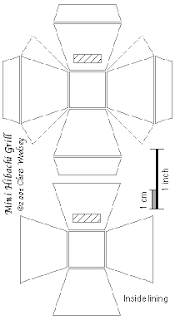 |
| The Haunted Halloween Mansion |
October 5th - 14th 2012
Ok, so as usual, I am easily distracted.
I am working on planning a little Halloween decorating (since here in Italy it is not really celebrated or it’s celebrated the wrong way - with fire crackers and general tricks instead of treats) which I usually do for a selected group of friends and their kids. So I like to do a nice table with scary stuff and sweeties. As I’m searching around, I came across some really cute
printable caskets and coffins to be used for putting candy or whatever on the table. As I’m navigating the page, I realise that this page,
Ravensblight, also has a
printable haunted house. Now THAT is just what I needed!
When I was a kid (young like maybe 11 or 12 because we were still living in Boston), I remember building from cardboard scraps a haunted house. Course I remember this little cardboard masterpiece as a mansion so I’m sure it was just scotch taped pieces and drawings all over the place. I was pretty creative even back then so it was probably pretty cool but my desire to have the house hang around on the back porch (a closed-in porch my Dad referred to as his “boudoir”) and eventually my Mom got sick of seeing it and told me to chuck it out. So, I suppose I reluctantly did.
Now this house building thing it seems has always been in my psyche since the haunted house building days to my gigantic gingerbread house at Christmas (with stained glass windows from melting hard candy which - when finally broken down and thrown out was carried off by some neighborhood dog), so, when I saw this printie, I knew I had to make it and make it better.
It took a good week of actually printing off all the 22 pages (of which my ink cartridge died so I had to get a new one), cutting and testing a few methods of gluing to see which one took quicker. But once I got in the groove, the house went together quickly.
I added a few of my own embellishments. I spread some glue on the grass patches and sprinkled that with brown and green grounds used in train HO landscaping. Then I added some bushes and even lit the garden lamp with one of my LEDs that I am using for the ryokan dollhouse (I will remove the LED once Halloween is over).
The last addition was printing off a
haunted bride and groom plus a grim reaper from the same Ravensblight page. I just reduced them down to size and set them up on the porches. They look sufficiently spoooky.
Fun too is that the haunted house can actually be picked up to reveal a hidden box inside. I don’t know yet what I want to hide. Perhaps some candy body parts??
Happy Halloween !!!!
 |
| Haunted Bride & Groom |
 |
| Grim Reaper and his Hour Glass awaits.... |























































